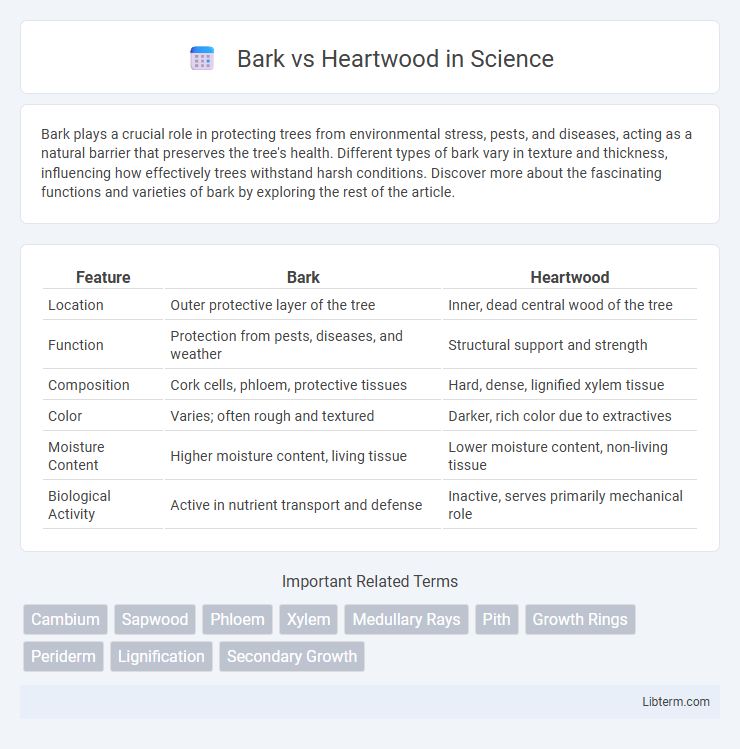Bark plays a crucial role in protecting trees from environmental stress, pests, and diseases, acting as a natural barrier that preserves the tree's health. Different types of bark vary in texture and thickness, influencing how effectively trees withstand harsh conditions. Discover more about the fascinating functions and varieties of bark by exploring the rest of the article.
Table of Comparison
| Feature | Bark | Heartwood |
|---|---|---|
| Location | Outer protective layer of the tree | Inner, dead central wood of the tree |
| Function | Protection from pests, diseases, and weather | Structural support and strength |
| Composition | Cork cells, phloem, protective tissues | Hard, dense, lignified xylem tissue |
| Color | Varies; often rough and textured | Darker, rich color due to extractives |
| Moisture Content | Higher moisture content, living tissue | Lower moisture content, non-living tissue |
| Biological Activity | Active in nutrient transport and defense | Inactive, serves primarily mechanical role |
Introduction to Bark and Heartwood
Bark is the protective outer layer of a tree, consisting of the outer bark and inner phloem, which helps shield the tree from environmental damage and pests. Heartwood forms the dense, central core of the tree trunk, composed of dead cells that provide structural support and durability. This inner wood is often richer in color and resistant to decay compared to the outer sapwood surrounding it.
Anatomical Differences Between Bark and Heartwood
Bark consists of the outer protective layers of a tree, including the outer bark and inner phloem, whereas heartwood is the dense, inner core of older xylem that provides structural support. Bark contains living cells involved in nutrient transport and defense, while heartwood is composed of dead cells impregnated with resins and tannins, enhancing decay resistance. Anatomically, bark features a multilayered structure with periderm and vascular cambium, contrasting with the lignified, non-living, and often darker heartwood at the center of the stem.
Formation Processes of Bark and Heartwood
Bark forms through the activity of the vascular cambium, producing outer protective layers including the phloem, which transports nutrients. Heartwood develops from older xylem cells that undergo a process of chemical transformation and lignification, resulting in a dense, durable core that provides structural support. While bark continuously regenerates to protect the tree, heartwood remains fixed, serving as the central strength provider.
Functions of Bark in Tree Physiology
Bark serves as a protective layer, shielding the tree from physical damage, pathogens, and insect invasion, while also reducing water loss through its impermeable outer surface. It plays a critical role in nutrient transport via the phloem, facilitating the movement of photosynthates from leaves to roots and growing tissues. Furthermore, bark is involved in gas exchange through lenticels, enabling respiration necessary for tree metabolism and growth.
Roles of Heartwood in Structural Support
Heartwood provides critical structural support by offering enhanced durability and resistance to decay compared to bark and sapwood, as it contains concentrated deposits of resins, tannins, and other extractives that strengthen its density. Unlike the outer bark, which primarily serves as a protective barrier against environmental damage and pests, heartwood acts as the main load-bearing core of a tree, maintaining rigidity and stability. Its natural resistance to fungi and insects makes heartwood essential for maintaining the long-term integrity and strength of wooden structures and living trees alike.
Chemical Composition: Bark vs Heartwood
Bark primarily contains high concentrations of suberin, tannins, and phenolic compounds that protect the tree against pests and environmental stress. Heartwood is rich in extractives such as lignin, flavonoids, and various complex hydrocarbons, providing structural support and decay resistance. The chemical differences between bark and heartwood reflect their distinct biological roles, with bark acting as a protective barrier and heartwood contributing to the tree's mechanical strength.
Ecological Significance of Bark and Heartwood
Bark serves as the tree's protective shield against pests, diseases, and environmental stress, playing a crucial role in maintaining ecosystem health by supporting diverse insect and microbial communities. Heartwood contributes to structural integrity and long-term carbon storage, enhancing forest resilience and acting as a significant carbon sink. Together, bark and heartwood support biodiversity, carbon sequestration, and ecosystem stability in forest environments.
Commercial Uses and Economic Value
Bark, primarily used in tannin extraction, medicinal products, and mulching, contributes to industries like leather tanning and pharmaceuticals, offering moderate commercial value. Heartwood, distinguished by its durability and resistance to decay, serves as a preferred material in high-end furniture, flooring, and construction, commanding a higher economic value due to its strength and longevity. The economic significance of heartwood surpasses bark because of its extensive use in premium wood products and longer market life.
Durability and Protection: Bark and Heartwood Compared
Heartwood offers superior durability and protection due to its dense cellular structure and natural extractives that resist decay, insects, and fungi. Bark serves as the first line of defense against environmental threats, preventing moisture loss and physical damage, but it is less durable and more prone to degradation over time. The combination of protective bark and resilient heartwood ensures overall tree longevity and structural integrity.
Conclusion: Choosing Between Bark and Heartwood
Choosing between bark and heartwood depends on the specific application and desired properties. Bark provides protective, outer layers rich in tannins and fibers, ideal for natural dyes, textiles, and bark-based products. Heartwood, being dense, durable, and resistant to decay, excels in structural uses, furniture, and flooring where longevity and strength are critical.
Bark Infographic

 libterm.com
libterm.com